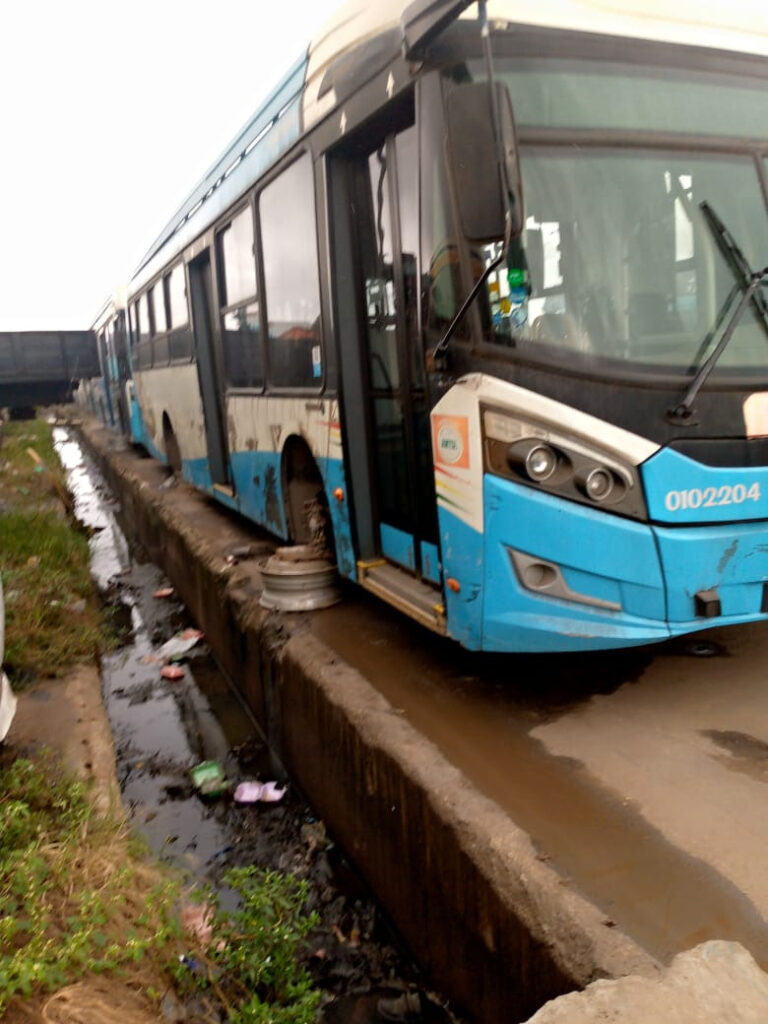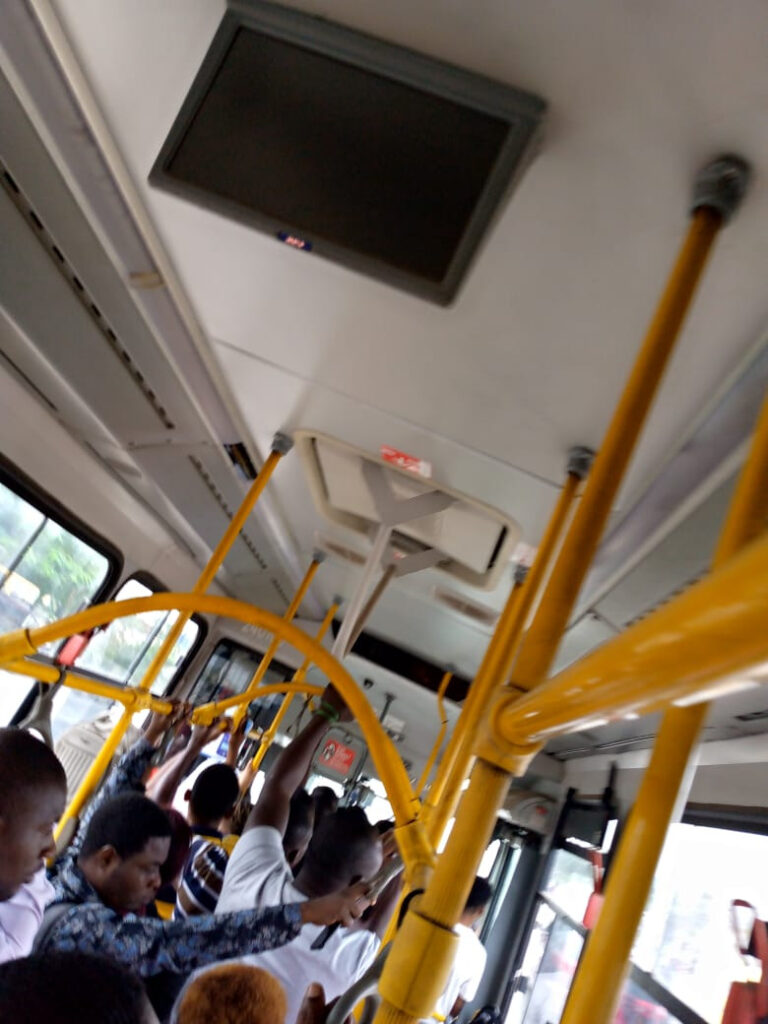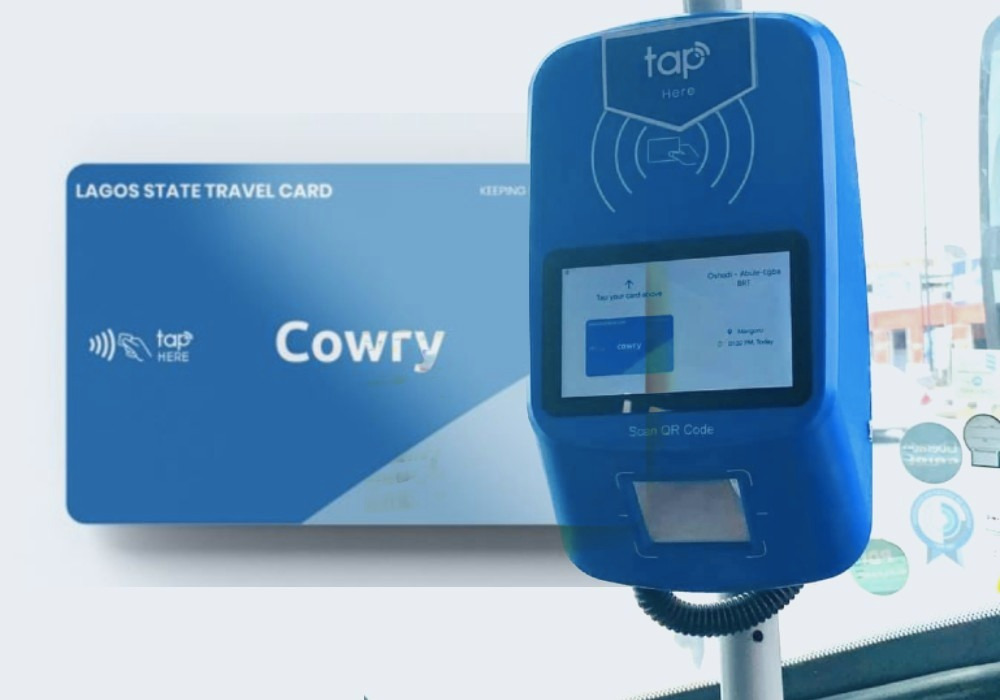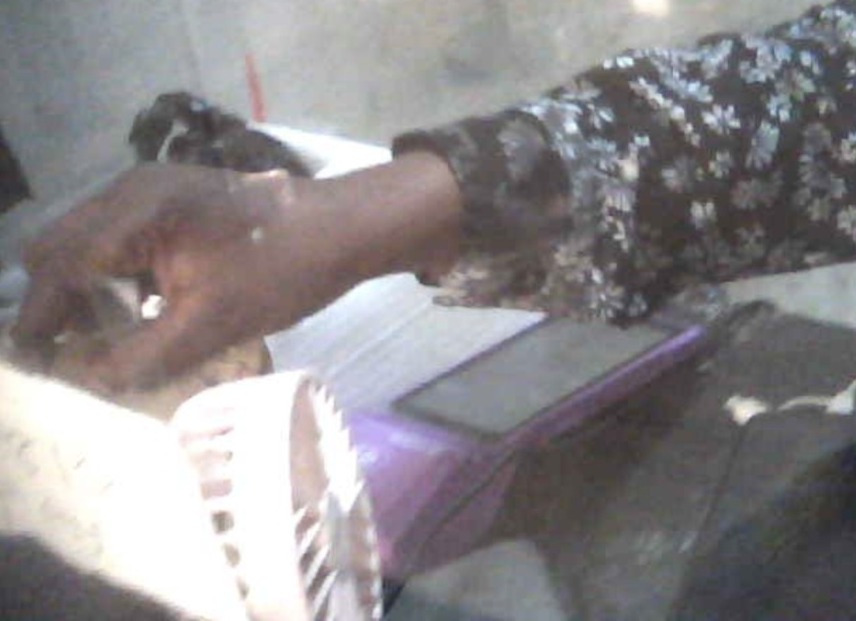Even though it received a rousing welcome when it was first introduced in 2008, Lagos’ BRT (Bus Rapid Transit) scheme is now a tale of overloaded buses, stuffy interiors, staff gaming the system, poor maintenance culture, delay in arrival of buses, corruption, rude personnel, reckless drivers, and everything in between.
In this investigative report, Quest Times’ AROGBONLO ISRAEL took a ride in BRT buses for a month, documenting his experiences with a spy camera.
The BRT scheme was supposed to sanitise a chaotic mass transit system in Lagos, but it hasn’t lived up to its billing.
ALSO READ: Inside Oshodi underbridge where homeless kids find ‘comfort’
Israel rode in BRT buses from Oshodi to Abule Egba, TBS, Ikorodu, Ikotun, Ajah, Berger, CMS, etc. — he took a tour across all the designated terminals where BRT picks up commuters in Lagos, at each stop, documenting the rot in the system.
His story is a compelling read…
A brief history of Lagos BRT
While transportation is an integral part of human existence, it is even more so in Lagos, Nigeria’s most populous city and commercial capital; as commuters put up with all sorts of challenges while moving around a frenetic city famed for its gridlock and bedlam.
The yellow and black striped buses – Molues and Danfos – were a menace; and the Danfo is still as creaky as ever with drivers who sip alcohol before hitting the roads.
The Molues (long buses), usually transformed Bedford or Mercedes Benz 911 trucks and Danfos – Volkswagen minibuses – are poorly maintained, dirty, crowded, and uncomfortable. For many Lagosians, it was an unpleasant experience riding on these public buses.
BRT buses were supposed to replace the aforementioned and confine them to the dustbin of history. They were supposed to be a breath of fresh air.
With the emergence of BRT in 2008–an initiative of the Bola Tinubu administration–there was an infusion of fresh air to what was a chaotic intra-state mass transit system in Lagos. This happened when the first phase of the Lagos BRT was opened. It was tagged “BRT-Lite.”
It operated on a 22-kilometre radial highway that connects Mile 12 and Lagos Island. That is, it ran from Mile 12 through Ikorodu Road and Funsho Williams Avenue, Eko Bridge up to CMS.
In its first year, the BRT transported an average of 200,000 passengers daily.
In 2012, it carried 51 million passengers, averaging around 140,000 a day. Still, this was only a fraction of the passengers who would normally use private buses.
Subsequently, a second phase of the BRT was implemented, which extended from CMS to Mile 12 to Ikorodu.
26 bus shelters are offered along the Mile 12-CMS corridor; three bus terminals are also placed along the corridor (at Mile 12, Moshalashi, and CMS), with the bus terminal at CMS designed to integrate with transport modes of rail and ferry that are planned for future construction by the Lagos Metropolitan Area Transport Authority (LAMATA).
To enhance its operations, a franchise system was devised by LAGBUS to allow private sector participation in the BRT scheme.
In 2012, a LAGBUS franchise became operational. It started with 10 franchise companies, 17 operating routes, and 238 buses.
While the contract signed with LAGBUS by the franchisees was still running, LAMATA entered a controversial BRT franchise with another private firm, this time, Primero.
On January 6, 2016, the Ambode-led government banned the LAGBUS buses from the BRT scheme, denying them access to load or alighting passengers along the Ikorodu-Mile 12-CMS BRT corridor, following some violations by the operators.
The banned LAGBUS franchise buses were later moved to 14 other non-BRT routes identified by the LAMATA Master plan.
LAMATA, in a move that sparked controversy and suspicion, granted Primero Transport Services Limited, a private company, the exclusive right to operate on the lucrative BRT corridors in Lagos.
Meanwhile, details of the contract LAMATA signed with Primero remain shrouded in secrecy.
The BRT system is being managed by these four operators – Lagos State Buses Limited (LSBL), TJ Motors Ltd, Primero Transport Services Ltd (PTSL), and Amalgamated Transport Services Ltd.
Currently, LAMATA is in direct control of the BRT infrastructure; NURTW is in charge of LAGBUS operation.
Today, the BRT system is practically on a downward spiral, no thanks to the poor maintenance culture of its operators, among other aberrations.
The Lagos BRT blueprint
Lagos BRT was supposed to be a high-quality bus-based transit system that was initiated to deliver fast, comfortable, and cost-effective services at metro-level capacity for the benefit of residents.
To persuade users of private vehicles to make the switch, the vehicles are supposed to be fully air-conditioned, fitted with cameras, free WiFi (internet), USB ports to charge phones, a television for entertainment, and special seats for persons with physical challenges and the elderly.
The BRT regime was expected to infuse competition in Lagos’ mass transit scheme. BRT bus fares ought to be 30% less than the average, as stipulated in its blueprint. That is, from N100 to the N150 charged by Danfos. Reducing commuting time by 40%, and cutting the average waiting time by 35% were also essentials.
The BRT scheme was expected to run two shifts daily, that is morning and night.
During weekdays, BRT resumes morning operation from 6am and closes at 12noon, while the night shift starts from 4pm to 10pm.
On weekends, on the other hand, BRT starts its morning shift from 6am to 8am; the evening shift is from 2pm to 8pm.
“From top to bottom”
Based on our findings, BRT operators have deviated from some of the aforementioned blueprints for reasons best known to them.
There have been a lot of changes (on the negative side) in the BRT scheme, from its poor customer service to failed service delivery.
The saying “from top to bottom” has become an apt description of how the BRT system has been plagued by the “Nigerian factor” which has hampered its operations and led to a deviation from the blueprint.
Our findings
Poor maintenance culture

Quest Times observed that the lack of a maintenance culture that has been the bane of development in the country is rearing its ugly head in the scheme.
For instance, no fewer than 50 abandoned buses were parked at different terminals of the BRT operators, despite an apparent bus shortage, day-in, day-out.
Also, USB ports in some buses are no longer working, giving passengers who had planned to charge their phones, false hope.
Lack of organisation
Another issue our reporter noticed during the tour was a lack of communication, especially between passengers and drivers.
There is no supervisor or coordinator to inform the passengers of developments, leading to chaos most times.
Passengers who have been on queues for hours are told at the last minute that “our buses are not coming tonight.”
During one of these ugly scenarios witnessed by our reporter, some passengers who could not afford the exorbitant fares by the yellow buses, ended up being stranded, as they had no extra cash on them, save for the money loaded on their cowry cards.
A passenger who spoke on condition of anonymity, narrated her ordeal while using the BRT from Oshodi-Abule-Egba.
Her words; “They (staff) lack organisation and this is really affecting their operations. Imagine getting to the terminal after a busy day at work and then you have to stand for hours, waiting for a bus that you are not even sure if it is coming or not. They (staff) quite know that “beggars have no choice” so they treat us the way they like. It is really frustrating.”
She however recommended that the BRT scheme should checkmate these excesses affecting its smooth running and efficiency.
Bad PR
Poor customer service is another serious issue plaguing BRT operations in Lagos. Some passengers have alleged that the behaviour of some BRT drivers is no different from that of the yellow bus drivers, who are generally considered untamed and unhinged.
Some of the staff are also accused of impatience and being ready to embarrass passengers at the slightest provocation.
Our reporter witnessed a dramatic scene of a staff member at the Oshodi Terminal 1 removing his shirt to fight a passenger confronting him for allowing some passengers who were not on the queue access into the bus, thereby ignoring the existing protocol.
This is just one of the many ugly scenes of how poorly run the BRT system is.
Stella Ashinze, who is a regular user of BRT, recommended that there should be an improvement in the customer-staff relationship, while also calling for effective monitoring of staff performances in order to forestall overlapping duties.
‘44 standing, 40 seating’

Another issue is the fact that the BRT system has now been tagged by some passengers as “advanced molue” due to overloading, especially during peak hours (a strategy adopted by drivers to make more money for the company).
For instance, drivers explore “delay tactics” by arriving at the terminal late to pick up passengers.
By this time, some passengers who have been on the queue for a long time would have no choice but to join the standing queue to catch up with the available bus, since they don’t know when the next bus would be arriving.
Even though Lagos exited the 5th COVID-19 wave, there is still the possibility of transmitting cough, monkeypox, and other airborne diseases from one passenger to another as a result of overloading.
Despite the capacity of each big bus pegged at 40 seated passengers and 30 standing, making a total of 70 as indicated in the buses, during peak hours, the operators regularly take more than 100 passengers.
Our reporter reliably gathered that the small buses are expected to carry 27 seated passengers, while they are not expected to carry any ‘standing’ due to their fragility compared to the bigger buses. But there are instances where the smaller buses are also overcrowded during rush hour.
The BRT scam
When it was first introduced, many Lagosians, among other reasons, patronised the BRT system due to its comfort, but their expectation was soon cut short after all the bus drivers stopped turning the air conditioners on while onboard, for flimsy reasons that go against the blueprint of the system.
Despite the N100 increase in its fares, the BRT system has failed to offer some of the promised benefits.
Also, some buses do not have functioning tapping-out machines despite the bold inscription at the entrance that reads: “Tap out before exiting the bus.”
Those that have been victims of this ‘fraud’ allege that some of the drivers are fond of locking the tap-out machine, in order to deny passengers alighting on the way from collecting a refund.
Miss Elizabeth, who told our reporter that it was her first month (August) of using the scheme, was displeased with the BRT operation from the Oshodi-Abule Egba axis.
“As someone who wasn’t a resident of Lagos and hearing a lot about the BRT buses, I thought my experience would be as exciting as what I’d heard, but the reverse was the case.
“From the long queues to enter the bus because you have to wait for the buses to come, then you have to decide if you want to stand or sit because there are not enough buses, and you’ll want to beat time so the standing option is what you opt for.
“The sitting down becomes very uncomfortable because of those who are standing next to you and it’s almost as if you can’t breathe well and the air conditioner can’t even come on due to how stuffy the bus is…so you are left with the windows open and the smell from outside combining with the stench from within.
“It is actually a little faster to get to your route because they have their own lanes, but the process to get into the bus and then sit down throughout the drive makes it a little uncomfortable because of the overloading. And with how congested the buses are, the camera is definitely not functional,” she lamented.
The BRT fraud
Though the cowry card technology that automates fare payment for BRT is considered an expanded e-ticketing system, which seeks to create smart mobility through a cashless prepaid card, enabling passengers to travel to different parts of the state using the card on any of the BRT vehicles, the service is still poor.

By implication, the BRT staff now resort to ‘cashing-out’ on passengers in the guise of tapping them in with their personal cards.
Our reporter witnessed how a driver collected cash from some passengers, unknown to the supervisor who ought to reconcile the number of passengers onboard but failed to do so since that is now the norm for staff who have now turned the BRT system to their private businesses.
Passengers often complain about ticketers loading above the agreed amount, thereby exploiting them, especially when in a hurry.
Our reporter witnessed an account of a certain passenger who told one of the ticketers to load N500 but was shocked when the driver confirmed that there were no funds in her cowry card.
‘Agbero’ style of driving
Another issue noticed during the tour is the reckless driving by some drivers who have adopted the ‘Agbero’ style of driving and find it offensive when told by passengers to reduce their speed limits.
A particular driver from the Ikorodu-TBS corridor is a vivid example of how reckless some BRT drivers have become.
“He was so reckless that he forgot to close his back door while in motion,” as our reporter succinctly put it.
Though Primero Transport Services Limited, operator of the Bus Rapid Transit (BRT) in Lagos, said that it had sacked no fewer than 300 drivers in 2020 to ensure commuter safety, there is still room for improvement in terms of training and retraining of drivers.
Delay in arrival time
The original idea of the BRT system is promptness, with delays not expected to exceed 10-15 minutes.
Today, passengers spend hours at the terminals waiting for buses, increasing the average waiting time by 35%. Sometimes, these buses never arrive.
The scenario that played out on Sunday, August 7, 2022, at the Ikorodu garage terminal, was most painful and a display of gross inefficiency on the part of the operators, as noted by our reporter. It was worse for passengers who were waiting for buses heading to TBS and Costain.
The buses plying Oshodi and Fadeyi routes arrived in trickles; like one every 30 minutes. But, because of the situation, the exhausted passengers on the queue were grateful that at least they were not completely abandoned. Some passengers who could no longer wait had no choice but to patronise their first love — Danfos.
Begging on duty

Despite being paid by the BRT operators, some staff has resorted to soliciting funds from passengers who they perceive to be financially buoyant, an act considered to be unprofessional and a dent to the scheme’s brand identity in the eyes of the public who may think they are not well remunerated.
One of the ticketers shamelessly asked our reporter for a tip during one of his tours. “Show me love na,” the young lady stylishly told our reporter after loading his card.
There are other instances where staff beg for money or even request drinks from passengers in the guise of being friendly with them, which the management should as a matter of urgency look into.
The ‘VIP treatment’
One serious challenge that has got passengers’ tongues wagging is the attitude of some of the staff and drivers. Customers should be decently treated. However, some staff use the slightest opportunity to transfer their frustration on passengers by questioning their integrity on matters of concern.
For instance, passengers often complain of some staff handing the ‘VIP treatment’ to certain individuals they consider friends or family members, who usually don’t deem it fit to join queues since “their brother is working with BRT.” This unwholesome practice has demeaned the scheme and needs to be checked.
Dammy Ogunsakin, who regularly boards BRT buses, has experienced this unpleasant aspect of the scheme. She accused the driver of picking up passengers outside the terminal, while many passengers were waiting for a bus inside the terminal.
She said: “I think their drivers must be constantly trained to reflect professionalism. I recall one instance when I was waiting at the terminal for the bus, when suddenly I noticed the lady in front of me left for a while.
“By the time the bus arrived to pick us up, the lady, alongside some other passengers, was already seated on the bus to everyone’s amazement.
“Not satisfied with what they did, we requested they (the passengers onboard) to alight and join those on the queue because we vividly remember they were on the queue with us, so how come they entered the vehicle before us?
“After much resistance, the driver obliged our request and asked them to join the queue.”
LAMATA reacts
Our reporter also reached out to the spokesperson of LAMATA, Kolawole Ojelabi, for a reaction to this story.
According to him, the agency only regulates the BRT scheme, adding that “the operators are supposed to operate between 6am to 10pm.”
When asked to elucidate on the relationship between the agency and the BRT operators, he said; “The synergy between us has been fine because we regulate their operations and if there are infractions, we deal with it.”
On the assessment of the BRT operators, the LAMATA spokesperson maintained that “we only regulate the BRT scheme and do not interfere in their affairs.”
He added that; “But if there are infractions that are reported to us and we know, then we take it up. We only intervene when such matter arises.”
On the poor maintenance culture among the BRT operators, Mr. Ojelabi said; “Well (sighs)… I cannot give you (referring to our reporter) comforting words because don’t forget that we’re operating a system where the cost of foreign exchange has skyrocketed.
“We don’t manufacture or produce anything here (Nigeria) and these buses (referring to the abandoned BRT buses) rely abroad for spare parts. So, if the vehicle goes bad and they exhaust what is in the store, they need to look for money to get the spare parts.
“Basically, what the government (LASG) is doing is to find a way to assist all these bus operating companies to see that all those buses (abandoned) that are on downtime are brought back into operation.”
Also, our reporter spoke to one of the LAMATA customer care representatives via telephone in a bid to know what the agency is doing to address some of the lapses affecting the BRT operations in the State.
“We are sorry about that (poor service delivery) Sir. We are constantly liaising with the bus operators to be able to address these issues raised. As you know, we are not the operators of the buses but the regulating agency to those operators,” the LAMATA customer care representative told our reporter.
On the issue of reduction of services despite transport fare hike, the LAMATA representative said; “Realistically, in all fairness, that is why we keep on liaising with them (BRT operators) to find a soft landing so as to break even. Of course, if they don’t make money too, they won’t be able to bring out the buses.
“The fare was hiked following the diesel price hike which is now about N800/litre. The increase in their expenses is not proportional to the increase in the transport fare. As I earlier said, we are still liaising with them and hopefully, before the end of this month (September), all the buses should be fully air-conditioned.”
Primero Transport Services, the private company that runs the BRT scheme, could not be reached for comments before this story was published. Repeated calls and text messages to their contacts were neither picked nor responded to.
Watch full video of the undercover investigation below;







